Home » Jazz Articles » Building a Jazz Library » Frank Sinatra: The Capitol Records Albums, 1954 to 1959
Frank Sinatra: The Capitol Records Albums, 1954 to 1959

Recorded during the crumbling of his marriage to Ava Gardner, this is where the idea of a concept album took firm hold, with the melancholy Sinatra, his mellowed voice immersed in Nelson Riddle's glorious yet understated arrangements.
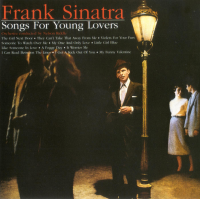 Songs For Young Lovers
Songs For Young LoversCapitol
1954
The long-playing (LP) 33 1/3 rpm record album was introduced in 1948. By 1954, the year of the release of Sinatra's first Capitol Records album, Songs For Young Lovers, the format had taken hold, pushing the 78 rpm music experience toward extinction. This Capitol Records debut set the stage for things to come. Arranged by Nelson Riddle, the two saxophones, four strings and a rhythm section backing was sparse in comparison to the future collaborations of Sinatra and Riddle. The sound was by turns lively and lush, introspective and bon vivant. The song choices—and in this Sinatra played a big part—were perfect for Sinatra's vocal style, whether he was crooning a gentle ballad ("My Funny Valentine") or going bright and bouncy ("A Foggy Day"). The bar was set high here; this one seemed as if it was going to be hard to top.
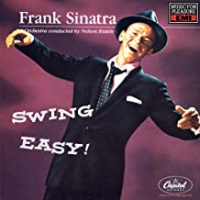 Swing Easy
Swing Easy Capitol
1954
Swing Easy teamed Sinatra with, once again, the arrangements of Nelson Riddle. This, like its predecessor, was an eight-tune, 10-inch LP—the early version of the format. It is, in the amount of music offered, a far cry from the compact disc's potential for nearly eighty minutes of music. Indeed, the 1987 compact disc release that included both Songs For Young Lovers and Swing Easy has a playing time of just over 40 minutes. Swing Easy, like its predecessor, is a set of highly-polished sounds—well-crafted, well-chosen gems from the Great American songbook, with Sinatra at his brightly smiling, insouciant best, swinging easy indeed, sounding like the coolest man in the world.
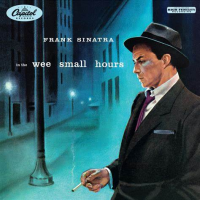 In The Wee Small Hours
In The Wee Small HoursCapitol
1954
This is where the idea of a concept album took firm hold, with the melancholy Sinatra, his mellowed voice immersed in Nelson Riddle's glorious-yet-understated arrangements. The unifying themes are love lost, fading romantic relationships and a grudging acceptance of bitter heartbreak. It was recorded during the crumbling of his marriage to Ava Gardner, and Sinatra sounds as if he sees no light at the end of the tunnel of his loneliness. In the Wee Small Hours is one of Sinatra's darkest albums. Also one of his most beautiful. It is one of two absolute masterpieces discussed in this article.
 Songs For Swingin Lovers
Songs For Swingin LoversCapitol
1956
This is the second masterpiece explored here. Another concept album, Songs For Swinging Lovers takes a 180-degree theme change from In the Wee Small Hours. It is jazzy, hip and exuberant—a celebration perhaps of the vocalist's rediscovery and joy of romantic love after a period of hard times in that arena. Sinatra was a man who wore his emotions on his sleeve in the recording studio. Songs like "You Make Me Feel So Young," "You're Getting To Be A Habit With Me," "Too Marvelous for Words" "Love Is Here To Stay" say it all about the man's state of mind at the time. Of special note is Sinatra's take—and Nelson Riddle's arrangement—of Cole Porter's "I've Got You Under My Skin." Sinatra moves from a smooth purr in the tune's opening to a powerhouse "belting it out" (like someone in love) in the chorus, and trombonist Milt Bernhart blows one the finest trombone solos ever recorded, an interlude that should be considered one of the ten wonders of the musical world.
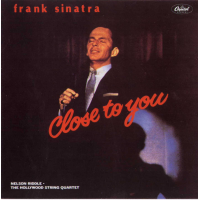 Close To You
Close To YouCapitol
1957
Close to You is the sleeper on this list. It wasn't initially as popular as the rest of the listed albums, and the tunes weren't as readily recognizable. That said, Close to You is an expertly-crafted album, one on which Nelson Riddle went heavier on the strings, making the sound lush and sweet. Not a masterpiece like the two albums that preceded it, but still excellent. Sinatra is in fine voice, sounding strong and relaxed and at peace with the world.
 Swingin' Affair
Swingin' Affair Capitol
1957
Sinatra hit his stride in 1955, and he kept it up with 1957's Swingin' Affair. His phrasing, his way with the rhythm and swing, his ability to get the emotional core of a song—it is all here on Swingin' Affair. Brassy and jazzy, this one hits hard. Consider here Sinatra's take—as a vocalist at the peak of his considerable powers—on Rodgers and Hart's "I Wish I Were In Love Again." The swing is effortless, Riddle's arrangement superb, and the lyrical content, which could be described as "not suitable for all audiences," telling the tale of a tussling couple, throwing plates and blackening eyes, in addition to the surprisingly naughty (especially considering this was 1957) proclamation: "When love congeals, it soon reveals, the faint aroma of performing seals." How did that one get past the censors? But Sinatra wishes he were in love again.
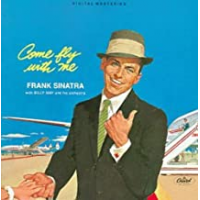 Come Fly with Me
Come Fly with Me Capitol
1958
Come Fly with Me featured Billy Mays stepping into Nelson Riddle's role as the arranger. He did a marvelous job of, crafting sounds that were a bit breezier than Riddle's, with a somewhat heavier hand when it came to the strings. The theme was straightforward: A musical trip around the world, beginning with the title tune, written at Sinatra's request by Sammy Kahn and Jimmy Van Heusen. The tunes leaned away from the more familiar fare. "Brazil," "Isle of Capri," and "On The Road To Mandalay" gave the album a change of pace, while still mining the Great American Songbook, with "Autumn In New York" and "April In Paris." Maybe not a blue ribbon Sinatra outing, but it was hugely popular, hitting the Billboard Chart's top spot and staying there for five weeks.
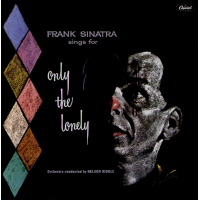 Frank Sinatra Sings For Only The Lonely Only
Frank Sinatra Sings For Only The Lonely OnlyCapitol
1958
This is Sinatra tackling torch songs, much in the manner of In The Wee Small Hours Of The Morning. Self-pity, when that mood struck him, was a part of Frank Sinatra's make-up, and he mined the emotion for all it was worth, avoiding the overly maudlin, and instead embracing his blue moods to make great art. He sings Gordon Jenkins' "Goodbye" here. It may be the saddest song in the world, and Sinatra and Nelson Riddle turn it into gold. It is one of Sinatra's best ballad performances and one of Riddle's deftest and most beautiful arrangements.
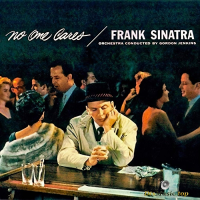 No One Cares
No One CaresCapitol
1959
Sinatra teams again with arranger Gordon Jenkins, on No One Cares, and "no one cares" certainly is the thematic motif for the entire album. This is Sinatra at his most melancholy—lonely, brooding, marinating in his indigo moods. This may be his most "woe is me" album, maudlin and bluesy, with Sinatra expressing his emotions with a genuine, "deep from the heart" delivery.
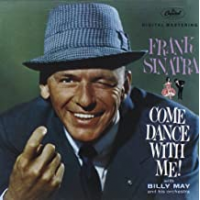 Come Dance With Me
Come Dance With MeCapitol
1959
A hugely successful album that spent two and a half years on the Billboard charts, it won Grammy Awards for Album Of The Year, Best Male Vocal Performance, and for Billy May's arrangements. It is as bright, brassy and as life-affirming as Songs For Swingin' Lovers. Sinatra belts these well-chosen songs out with gusto, in this dance through familiar Great American Songbook—"Come Dance with Me," Cheek To Cheek," "I Could Have Danced All Night," "Something's Got To Give." Sinatra sounds as if he is sitting on top of the world. In 1959, after releasing these ten masterful albums, he was.
< Previous
Momentum Space
Next >
Life
Comments
Tags
Building a Jazz Library
Dan McClenaghan
frank sinatra
Capitol Records
Songs For Swingin Lovers
In the Wee Small Hours
Come Fly With Me
Come Dance With Me
No One Cares
Frank Sinatra Sings For Only The Lonely Only
Swingin' Affair
Songs For Young Lovers
Swing Easy
For the Love of Jazz
 All About Jazz has been a pillar of jazz since 1995, championing it as an art form and, more importantly, supporting the musicians who create it. Our enduring commitment has made "AAJ" one of the most culturally important websites of its kind, read by hundreds of thousands of fans, musicians and industry figures every month.
All About Jazz has been a pillar of jazz since 1995, championing it as an art form and, more importantly, supporting the musicians who create it. Our enduring commitment has made "AAJ" one of the most culturally important websites of its kind, read by hundreds of thousands of fans, musicians and industry figures every month.























